Demystifying poker tells, the game's silent communicators, is a vital skill for aspiring champions. Discover more in our complete guide.
Poker is not just about the cards dealt; it's about reading the players around the table.
In poker, the ability to interpret poker tells – the unconscious actions and behaviors that can disclose a player's intentions or hand – is as essential as understanding the game's rules.
With these invisible cues playing a pivotal role, you may ask: How can I decode these signals? What should I look for in my opponents?
This is where expert player Ashley Adams steps in, offering a comprehensive guide to poker tells.
Here’s what you’ll uncover:
Are you ready to elevate your poker game to new heights?
Imagine: It’s the final scene of a poker movie.
Our hero is playing for the championship of poker. His opponent, the villain, sits with his cards concealed.
He’s just made an enormous bet, shoving in all of his chips.
Our hero has a strong hand, but not the nuts. He must decide if his opponent is bluffing.
If he makes the right call, he will win the championship.
He stares at his opponent, who has on his best poker face, seemingly giving away nothing about the true strength or weakness of his hand.
After a few seconds of staring, Hero notices that the Villain’s left eye ever so slightly starts to twitch. He remembers that in an earlier hand, Villain had this same twitch when he was bluffing.
Hero calls the all-in bet.
Villain, looking disgusted, throws down his cards showing he had nothing and was bluffing. He exclaims, “Damn you! How did you know I was bluffing?!”
Hero is pushed an enormous pot, wins the championship, and has a subtle, knowing smirk on his face.
He says nothing; and the scene goes to black.
Ah, yes, reading tells in the movies. If only it were this simple.
Here’s the Truth about Poker Tells
The scene above has been shown, in one form or another, dozens of times in the movies, on TV, and on stage. It is the public’s view of what poker is all about:
- bluffing;
- reading opponents;
- having (or not having) a poker face.
But it is fiction.The real poker world doesn’t work like that.
In reality, all but the most rank beginners have pretty good control over their facial expressions while they are playing.
I’ve been playing poker for over 50 years, and I don’t think I have ever played against someone in a casino who was so guileless that they smiled or exclaimed “goodie” when they were dealt a good hand.
For the most part, the public’s view, and thereby the newcomer-to-poker’s view of tells is way off the mark and overblown.
Forget what you’ve seen on stage and screen. I’m going to show you what you really need to know to figure out your opponent and their likely holding.
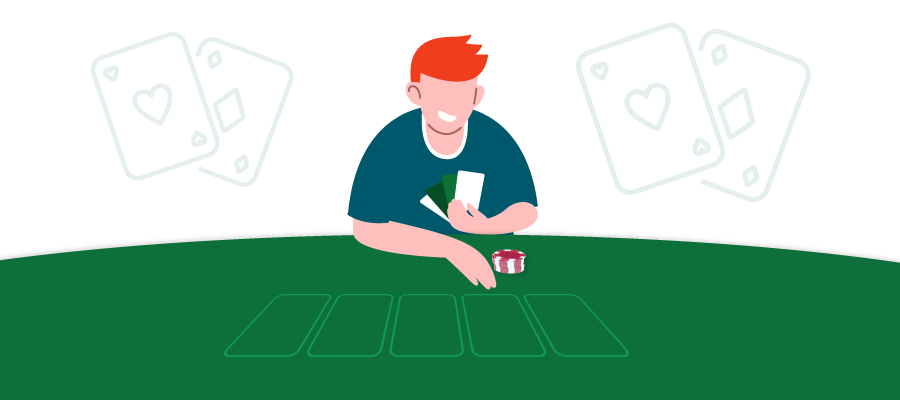
A tell is an action that tends to reveal the true strength of a poker player’s hand. An opponent’s action “tells” the perceptive player how strong they really are.
The perceptive opponent, aware of this “tell”, uses it to assess the true strength of their opponent’s hand; and then they bet accordingly to take advantage of this knowledge.
In the movies, such tells might be a twitch, a rolling of a ring, a scratching of the head, a yawn, or some other involuntary, unconscious action.
But in real life, tells rarely present themselves so clearly or frequently as to be of much use. In fact, focusing on them and looking to spot them tends to be a distraction.
I remember visiting a poker room early in my playing career. I wanted to work on my reading of tells.
I stared at each player at my table, watching keenly as they bet:
- I looked for some action that I could correlate to their hand strength.
- This one leaned forward, that one tossed his chips in casually, that one said raise, while another just shoved forward a stack of chips.
- I watched carefully trying to notice patterns that I could exploit.
Unfortunately for me, I didn’t come up with anything. I recall noticing a slight stiffening of posture when an opponent bet.
But did the slight stiffening in posture mean my opponent was more anxious because he was nervous about bluffing?
Or maybe he was more nervous, but more nervous because he held a good hand? Or maybe his posture stiffened because he had a bad case of gas!
I had no idea.
A Note On Poker Literature
There are some books about tells that you might read to your advantage.
Mike Caro’s written the best one, I think. It’s "The Body Language of Poker". Zach Elwood has a few. Joe Navarro has a couple too.
They’re good; and they give you things to look for. I’ve written some about it as well in my book "Winning Poker in 30 Minutes a Day" and in "Winning 7-Card Stud".
If the subject of tells really interests you, you should check these all out.
My Opinion on Poker Tells
Even so, I think that looking for tells like those covered in the sources above is starting off in the wrong direction.
While I do believe that it’s useful to know the simplest of the tells covered in this literature (and I review them briefly at the end of this article), I think you have to start with actions that are much simpler and more obvious, by considering not the unconscious actions of your opponent, but the conscious ones.
Don’t get me wrong. One of the most important skills you need to develop is the ability to figure out how strong your opponent really is.
And some part of that skill is your ability to notice unconscious and unintended physical actions, called tells, that may reveal the true strength of your opponent’s hand.
But typically, poker players go about it all wrong, and end up without much fruit for their efforts.
You should start by seeking to know whether or not your opponent is strong based on their conscious and intentional actions at the poker table.
Pro tip
Your first task at the poker table in this regard is not to look for small unconscious actions like facial tics or hand gestures, but rather to put your opponents into the broadest of categories.
Occam’s Razor and Poker
Occam’s Razor is a principle in philosophy that holds that the simplest and most obvious explanation is usually the correct one.
Rather than thinking about all possible explanations, if you want to figure out what’s going on, start with the most likely one.
Here's an example of this.
If you’re traveling on an American ranch and hear hoof beats approaching from the other side of a rise, it’s probably a rider on horseback, not a zebra.
Of course, it’s possible that it’s a zebra, released by an eccentric rancher who keeps rare animals. But, most of the time, when you hear the hoofbeats, think horse, not zebra.
This is also true in poker.
When your opponent makes a large bet, it could be a bluff.
But they probably have a big hand. When your opponent checks, they could be trying to mislead you while holding a monster. But they probably don’t have a very strong hand.
Players sometimes get into trouble in poker because they want to believe an unlikely possibility rather than the likely one.
There are always alternative possibilities to the most likely one.
An opponent’s pot-sized bet on the river may mean that they are bluffing with nothing. Their 3-bet pre-flop may just be them making a move to steal the pot.
Even so, you are generally better off discounting the possibilities that are less obvious, and going with the more obvious explanation.
Accordingly, when you’re trying to figure out what your opponent has, tend to believe that their betting action is telling the truth. It usually is.
Think horses not zebras!
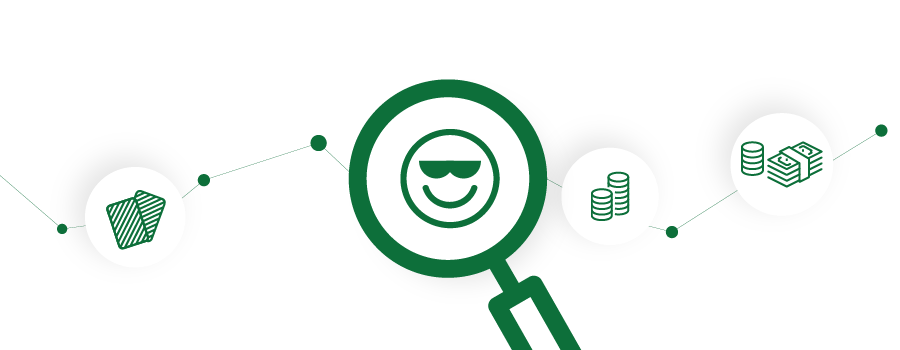
In World War II, before the widespread use of radar, the United States and Britain established a network of plane-spotters on their coasts to prevent a sneak attack.
They were trained to guard their country with a coastal defense that looked skyward to detect any enemy aircraft that might be flying over the border.
If they detected anything they called it in to alert defenses.
This proved extremely successful, as the Allies trained a virtual army of civilian plane-spotters, who provided an early alert system well before radar was developed to serve the same purpose.
The method of this training is very instructive for poker players.
Plane-spotters were trained to recognize not the small markings on every aircraft. Rather, they were given books with the silhouetted contours of every enemy plane.
They were trained to recognize the broad outline of the planes, not the fine details. This kept things simple, as the general outline was deemed sufficient to identify all enemy aircraft.
Getting plane-spotters to look for minute detail would have been an unnecessary distraction.
The same is true with regard to observing poker opponents. Looking too closely and for a lot of detail distracts from the job at hand.
You want to characterize opponents very generally – just the broad outline of their playing type.
Keep the categories broad; and keep them few.
Basic Categories of Play
Your first task in figuring out the meaning of an opponent’s betting action is not to look for a tell.
It is to put them into a basic category of player type, based on their general tendencies.
Most players tend to fall into a few basic categories, and may be cast into one of a few types, as defined below:
Most players are either tight or loose.
- A tight player plays few hands, with a narrow range.
- A loose player plays many hands with a broad range.
Most players are either passive or aggressive.
- A passive player tends to check and call.
- An aggressive player tends to bet and raise.
Combine these features to get a very simple and basic outline of your opponents.
- A loose passive opponent tends to call many hands, but seldom raises or initiates the bet. They are often known as “calling stations”.
- A tight aggressive player tends to fold except for high quality hands, when they tend to raise. They are often known as “TAGs”.
- A loose aggressive opponent tends to raise with a very large range. They tend to be known as LAGS or, when extreme, MANIACS.
- A tight passive player tends to play a narrow raise without much betting or raising. They tend to be known as “NITS” or “ROCKS”.
You get the idea.
Rather than first looking for many small unconscious actions to assess a player’s likely hand, use their player type and their betting action.
If a loose-passive, tight-aggressive, or tight-passive opponent raises, it probably indicates that they have a very strong hand.
On the other hand, if a loose-aggressive player raises, they may have any of a wide range of hands.
Refine these general categories as you get to know players better.
Some players are loose-aggressive pre-flop and on the flop, but then they tighten up and play more selectively on the turn and river.
Other players tend to be tight pre-flop, but then can’t seem to get away from their hands once they have initiated pre-flop action.
They are known to be “sticky”.
Still other players, who play a fairly tight game, tend to become wild and reckless on the river when they haven’t caught their hand, and are prone to make desperation shoves.
Add these observations to your book on each opponent and you will greatly improve your ability to figure out if they are strong or weak when they bet.
While you want to start by putting your opponents into the broadest of categories, like Tight-Aggressive and Loose-Passive, as you gain experience with your opponents you can further define their category by more precisely categorizing them.
You can then further differentiate them by thinking of a simple graph. One axis is their looseness quotient, the other is their aggressive quotient.
You can give each axis 5 points, and characterize your opponents accordingly.
- A 5/5 is the most aggressive and tightest player you can imagine.
- A 1/1 is the loosest and most passive player.
- A 3/1 is a moderately tight and extremely passive player.

You get the idea, yes?
Don’t forget the importance of position as you are doing this. Raises from early position tend to indicate stronger hands and more narrow ranges than late position raises.
Late position raises, on the other hands, generally indicate a broader range and a higher likelihood that an opponent is bluffing.
Use your opponent’s position and their playing type to deduce their likely range. A tight player, raising from early position, is very likely to indicate a truly strong hand.
A loose aggressive player doing the same thing from the button is much more likely to be a bluff.
The Context of Betting Action
When considering whether or not an opponent is bluffing, it’s important to consider not just the bet itself, but its context.
You need to recall and consider the prior betting action, and then decide if their current bet makes sense.
If it does, then they are less likely to be bluffing.
If it doesn’t – if it just seems to come out of the blue – then it is more likely to be a bluff.
Here’s an example of a player making a credible bet:
- You bet pre-flop, in position, with a pair of Queens and they called.
- The flop came As 9d 6s.
- They checked and you bet.
- They called.
- The turn was the 9c.
- They checked.
- You bet.
- They called.
- The river was the 5s.
- They bet half the pot.
Their river bet makes sense when viewed along with their earlier bets. Reconstruct the betting of hand, and you’ll see why.
You bet and they called. That indicates that they might have a drawing hand.
The flop was two-suited.
They checked and called your bet. That indicates that they were on a draw as well -- perhaps a straight draw with the 78, perhaps a flush draw with two spades.
The turn paired the board. They checked and called your bet, indicating they may have still been on a draw.
The river was a third spade and a 5, making a flush and a straight possible. They bet half-pot.
With all of the earlier bets in mind, this river bet makes sense, and is likely an indicator that they made a hand stronger than your Queens. As such, it would be a very well-constructed bluff for them. It tells a reasonable and convincing story.
On the other hand, imagine if the situation were different:
- They raised pre-flop, you 3-bet with your pair of Queens, and they called.
- The flop came As 9d 6s.
- They bet and you called.
- The turn was the 9c.
- They bet and you called.
- The river was the Qs.
- They bet half the pot.
You’d be likely to view them as having a big Ace and not the flush, yes? The bluff would be unlikely to convince you because the story didn’t make sense.
The bet doesn’t make sense as a flush, even though a third suited card hit, because the prior betting action and the final bet don’t add up.
They were the aggressor, in the earlier betting rounds, and were unlikely to be on a draw without some kind of a strong hand. So representing that they were playing two suited cards the whole way is harder to believe.
Of course, they might be deliberately misleading you, and betting their hand unconventionally. But most of the time, presume a conventional betting progression means what it appears to mean.
When you hear hoof beats think a horse, not a zebra!
Most of the time, a player’s type, their betting position, and their betting action will be sufficient for you to gauge an opponent’s likely range.
Even so, there are some seemingly unconscious actions by your opponent that can also help you shed light on the likely strength of your opponents’ hand.
Here is a list of what I call “Giveaway Tells”, and my experience with how reliable each one is.
1. Staring at the Flop

Mediocre and worse players tend to stare at flops for a while when the flop doesn’t help their hand. It’s a good sign of weakness.
They are looking for some way the flop might help them improve – but they’re not finding anything. It takes them a second or two longer because there is nothing there for them that is helpful.
This tell is faked by good and better players. Accordingly, against a completely unknown opponent I’d say it’s about 70% reliable.
2. Checking Hole Cards

A player who is very good or better has generally adopted the habit of only looking at their hole cards once, remembering them, and never checking them again.
Players worse than that, however, may re-check them.
They tend to do this for a variety of reasons. The most common reason is to see if the board has given them a flush draw.
Anytime I see an unknown opponent do this on the turn, when the board gets a third suited card, I assume that the board has not just given them a flush, but that they may be on a flush draw.
I reason they would know, without checking, if their cards were of the same suit; and they wouldn’t have to recheck.
But they might have forgotten which suits their two unsuited cards were. This is a very useful tell, as it helps you decipher their action accordingly.
If an opponent does this and then bets as if they have the flush, I tend to dismiss it (unless they are very tricky and capable of doing this as a bluff).
A few players do this as a fake tell. I’d say it’s about 85% reliable.
3. Checking Stack and Looking Away

The dealer deals part of the board. Your opponent steals a quick peek at his chips and then, almost as quickly, looks away.
This is almost surely a sign that the flop helped him – and probably helped him a lot.
The peek down at the stack is a quick and unconscious interest in their chips and in betting. The looking away is an attempt, also largely unconscious, to deceitfully attempt to show lack of interest in the hand and the game.
This is rarely faked. I’d give it a 95% score of reliability.
4. Staring at You

Players with weak hands sometimes try to look strong to deter you from betting into them. They adopt a tough guy stare to do the trick.
This is usually a sign of weakness that tends to prompt me to bet.
This one is faked a fair amount of the time. I give it a 70% chance of reliability.
5. Talking

Players tend to talk about their hand when they have a good one and want to encourage you to call. When I’m contemplating a call, I usually fold if my opponent is talking to me about the hand. It doesn’t matter to me what they are saying.
Similarly, if I’m contemplating a bluff, I typically am dissuaded from it, all other things being equal, if they’re talking to me about the hand.
I assume they’re strong and will call or raise.
6. Grabbing Chips Prematurely
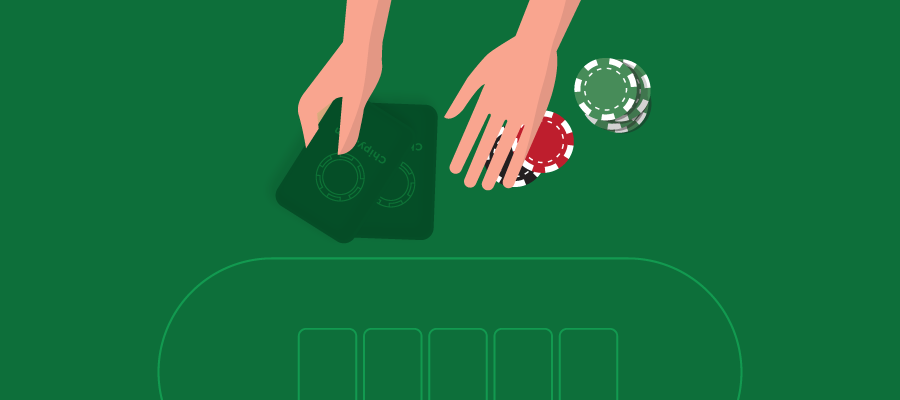
Really bad players, maybe in a casino game for the very first time, might do this by mistake – thinking it’s their turn.
But most of the time, when an opponent prematurely grabs their chips, or holds on to their chip stack, it means they have a weak hand and are trying to discourage me from betting.
Don’t fall for this acting. It’s almost always a sign of weakness.
When I see someone grab their chips, unless I know them to be a brand-new player, I typically bet into them, expecting them to fold.
I’ve rarely seen this faked. But sometimes a player is legitimately bad enough to grab their chips early by mistake. Knowing that I’m facing a good player, I’d say this tell is about 90% reliable.
7. Staying Completely Frozen
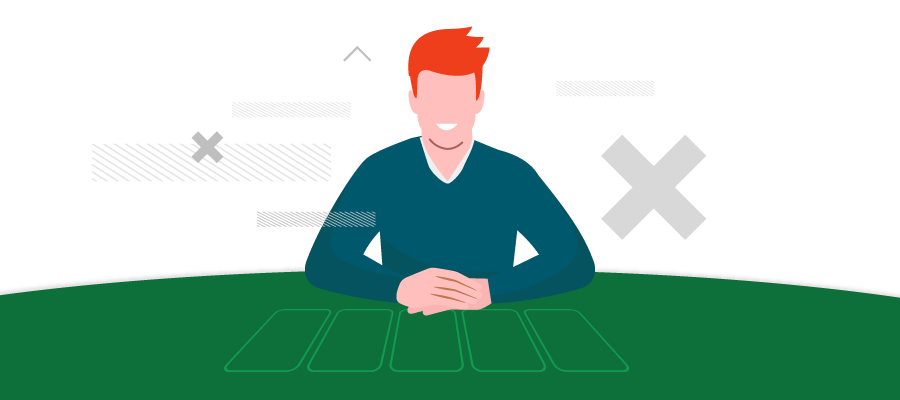
This is a commonly cited bluffing tell.
The thinking goes that a player who is bluffing doesn’t want to draw attention to themself, and so they try to completely immobilize themselves, lest you spot something fishy.
I have not found this to be a very reliable tell.
Many players tend to do this when they are value betting an extremely strong hand as well – as they attempt to make sure you don’t find a reason to fold. It is only very slightly more reliable than not.
When my opponent freezes during my decision, I look to other signs that they might be bluffing.
I’d give this a 55% reliability factor.
8. Getting Ready to Leave the Table

This is a situational tell. A bet from a player in this situation indicates strength. A player in this situation invites a bluff from me.
A player getting ready to leave is a good target for a bluff because they tend not to want to get involved in a hand unless they are really strong. It’s also a good tell that they are legitimately strong if they are betting in this situation.
It is the rare exception that a player getting ready to leave will bet as a bluff or call a bet with a weak hand (unless they’re down to only a few chips that they figure they’ll throw away into a longshot draw).
I’d rely on this tell 95% of the time.
9. A Hand that Shakes
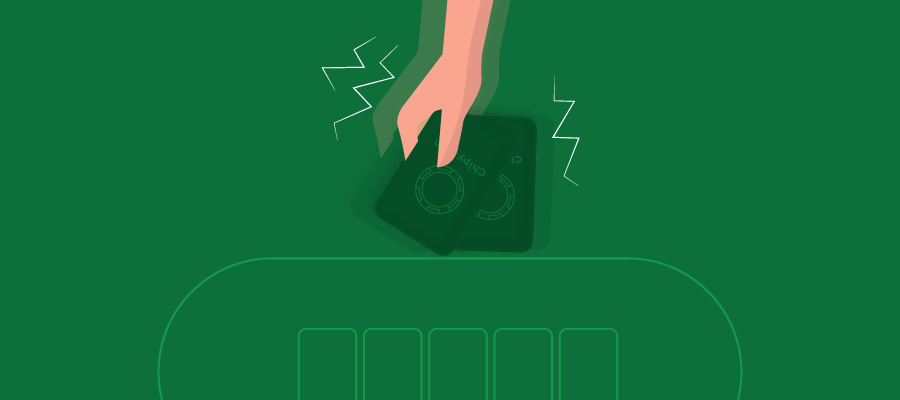
Players sometimes have hands that shake when they bet.
This may indicate that they are loaded, and made anxious by the enormity of their hand. This may indicate that they are bluffing, and anxious about being called.
Or, as in my case, it may indicate that they have an essential tremor – that increases with any stressful situation.
I’ve found that more than half the time – maybe two thirds of the time – it indicates true hand strength, as the hand shakes out of a released anxiety from being so strong.
Knowing nothing else, I’ll tend to believe that my opponent’s betting action, coupled with a shaking hand, indicates they have a very strong hand.
Call it 66% reliability for this tell. But it’s not a certainty. And I caution care when evaluating it.

You want to make sure you aren’t revealing the strength of your hand with your behavior.
Accordingly, I try to be systematic in how I act whenever it is my turn to bet or when I am otherwise in a hand.
I look at the flop, look at my hand, and look at other players in the same manner no matter my holding.
With the exception of immediate folds, I will pause at least 1-2 seconds before acting – whether it is a call or a raise, a value bet or a bluff.
I counsel my students to adopt this intentional pause to avoid giving away any indication that a betting action is a close call.
Always pause for at least a second or two so those times when you have to hesitate because you really aren’t sure what to do will not be obvious.
I also refrain from talking when I or my opponent must make a decision about what to do. I don’t want to give off any talking tells.
In general, I advise new and intermediate players to refrain from any talk when they are in a hand, and to handle their chips and their cards in the same manner whether they are weak or strong. Get into a habit of play that is routine, and you will avoid giving off tells when you bet.
There are a few other things you can do to avoid having your opponents correctly define your range.
1. Mix up the level of your aggressiveness, especially when you are viewed as tight
You do not want to be typed as someone who only plays the very narrowest range. It will kill your action when you have a monster hand, and it will make you too predictable.
Instead, make sure to increase your level of aggression, even at times when you are on a draw, especially when you have gone a good many hands without entering a pot.
Take advantage of your recent poker image by bluffing (ideally semi-bluffing) when you think you are viewed as a rock.
2. Do not limit your bluffing action to betting weaker hands.
Even when you are moderately strong, include in your arsenal those betting actions that are unusual unless you are really strong.
For example
If an opponent makes a c-bet, and you have position, raise him significantly from time to time. Don’t make a habit of this. But if your image is at least fairly tight, your re-raises are likely to be believed, and you’ll pull off a successful bluff.
Risk the hyper-aggressive betting action that will almost surely be believed.
3. Take advantage of a loose image with over-sized bets
Your recent betting history may paint you as a wild player. Take full advantage of that by being hyper-aggressive.
Shove occasionally in those spots when you think you’re in the lead, even if your typical bet size would be much, much smaller.
Remember
The success of your ploy is not measured just in the frequency you are called, but in the frequency you are called multiplied by the size of the bet.
Here’s an example of that:
Imagine there is a one-suited flop and you have hit a flush.
Your image is spewy – because you were just caught bluffing or you have been in a bunch of hands for a raise lately.
The pot is $50.
You have an effective stack of $300, and it’s checked to you. You are tempted to bet just $25 to entice some callers.
Instead, shove!
If no one calls you win $50. But if someone calls (thinking perhaps that no one who hit a flush on the flop would bet so aggressively) you will win $350.
Your insane shove might cause opponents to fold many times. But if it gets called, that one call equals the same return as 14 calls of $25.
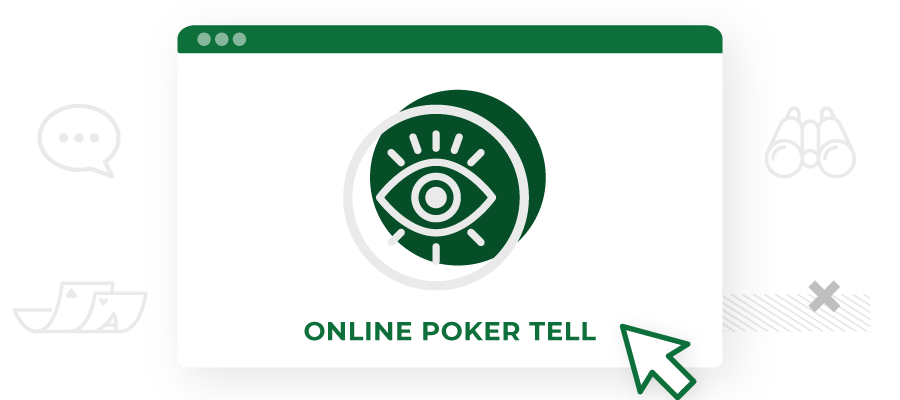
Many poker theorists discount the possibility of picking up tells online. They reason that you can’t see your opponents, you can’t possibly pick up any tells.
Though this is generally true, there are many things that help you read your opponents online.
First of all, as I mentioned earlier in this guide, players can be put into different categories that tend to indicate the likelihood that they are strong or weak in different situations.
Combine these player types with their betting action and their position, and you can deduce their range of likely hands.
You can use a HUD to keep track of these player types. You can check my article on online play for more information about this.
There are also limited timing tells that you can read online.
You can get some idea of the likelihood that your opponent is bluffing or value betting based on the time it takes them to bet.
Conventional wisdom holds to the following signs of strength and weakness:
- A player with a very quick check is weak.
- A player with a very quick call is weak.
- If a player bets very rapidly after the flop, turn, or river, it indicates at least a fairly strong hand.
- A player who pauses longer than typical and then calls or checks has a weak hand.
- A player who pauses longer than typical and then bets or raises has a very strong hand.
I find these to be only slightly more accurate than not.
Before using any of these timing tells to assist my reads, I would look at my opponents playing type, their position, and whatever history of their play I can access to determine the likelihood that their betting action truly indicates the strength of their hand.
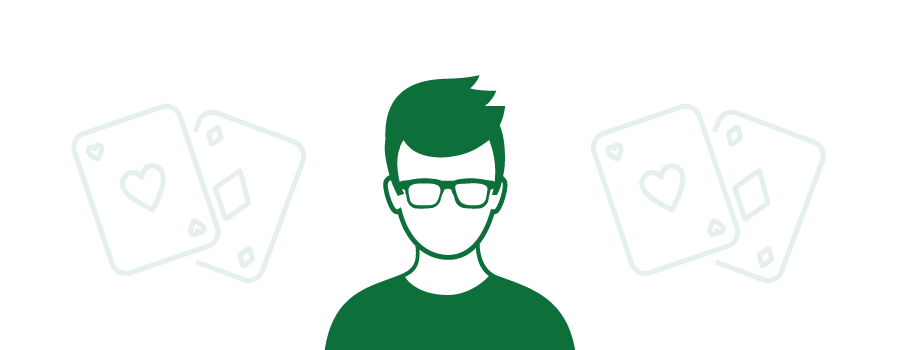
What is the best poker face, to avoid giving off tells, and to make money?
When we started this guide, I created a poker scene from a typical and unrealistic poker movie, mentioning bluffing and a poker face in the process. What is the ideal poker face?
Picture the stereotypical one. It is often stern in its seriousness and unreadability. It’s meant not just to conceal the true strength of the hand but to intimidate the opponent.
I suggest that this is NOT your ideal expression at the poker table.
Think about how you make your money when playing poker.
Chiefly, your profit comes not from making clever or deceptive plays that fool good poker players, and not from intimidating opponents into folding, but rather from poor, mediocre, and beginning players losing their money to you because they are too naïve, stupid, inexperienced, or undisciplined to know or make the right play.
Ask yourself whether you’re better with those players in or out of your game?
Your default expression should be one that is most likely to entice those poor suckers to play against skillful you, shouldn’t it?
Do you think a stern, cross, serious, intimidating mask is the best to don for that purpose?
I’d argue against it.
If you want to keep the bad losing players in your game, you’re better off, for purposes of profit, being perceived as an affable, easy, relaxed player – someone not to be feared. Your facial expression should reflect that.
Accordingly, I counsel that the best poker face is an easygoing smile.
Further, look at it this way. Even if you fail to keep your losing opponents playing and losing against you, a smile will help you enjoy the game.
Conclusion
There are giveaway tells, that can help you detect when and whether an opponent is strong and weak; and whether they are betting for value or bluffing.
But these tells are not nearly as important as the much bigger clues to a player’s hand that they give off by their betting action and their general style of play.
Learn first how to properly characterize a player. Then tend to believe that their strong betting action indicates strength.
Finally, when there are close calls, refer to the giveaway tells that I supply you with here. And remember, as you are seeking to look inscrutable, not to get carried away with your seriousness of purpose.
The most profitable behaviors and expressions at the poker table are those that encourage the bad players to continue playing against you. You can learn more about mastering the art of poker from my guides here on Chipy.

Bonuses
Casinos
Games
Academy
News
Shop
NEW Q&A
Sweepstakes


































